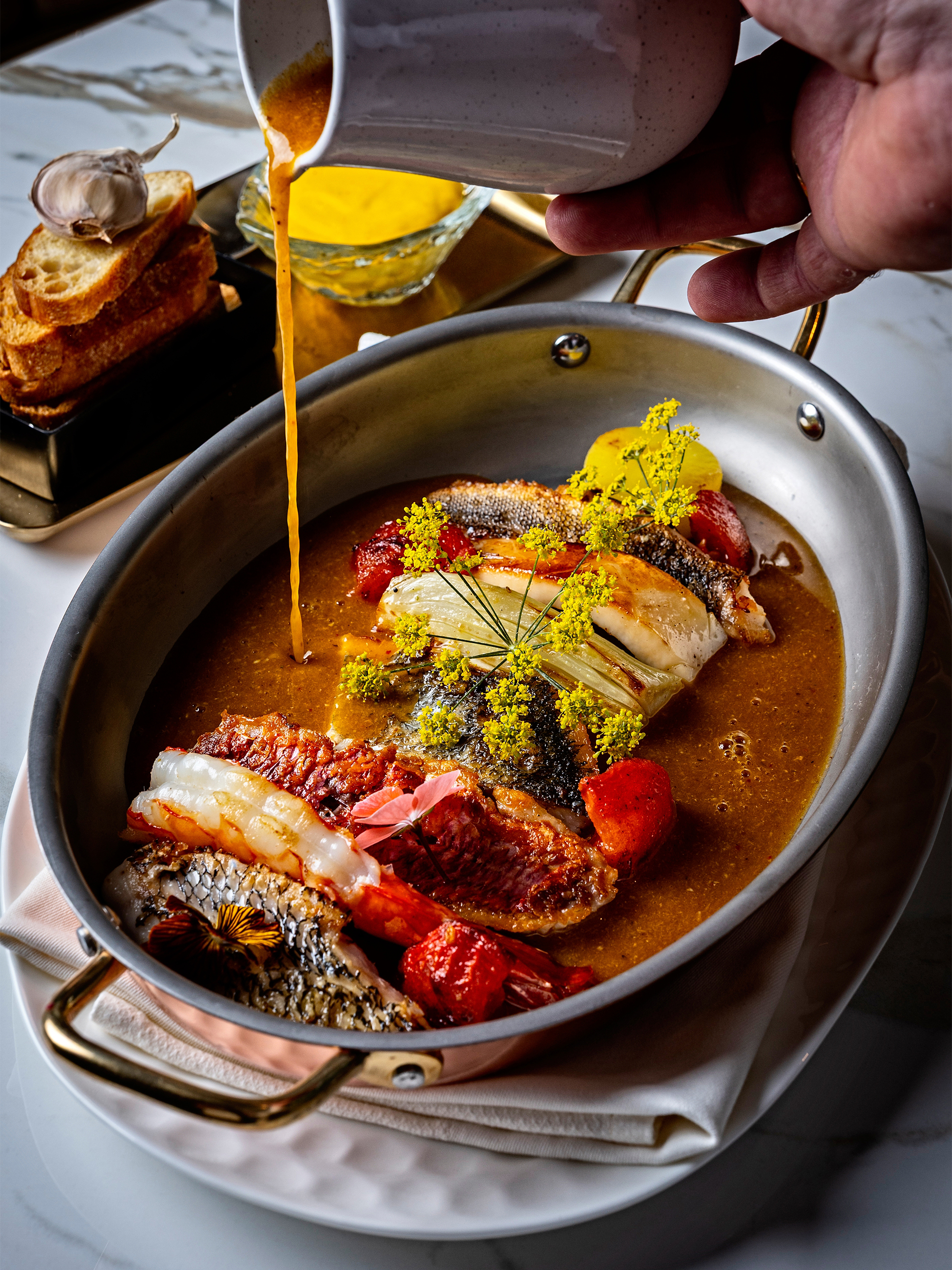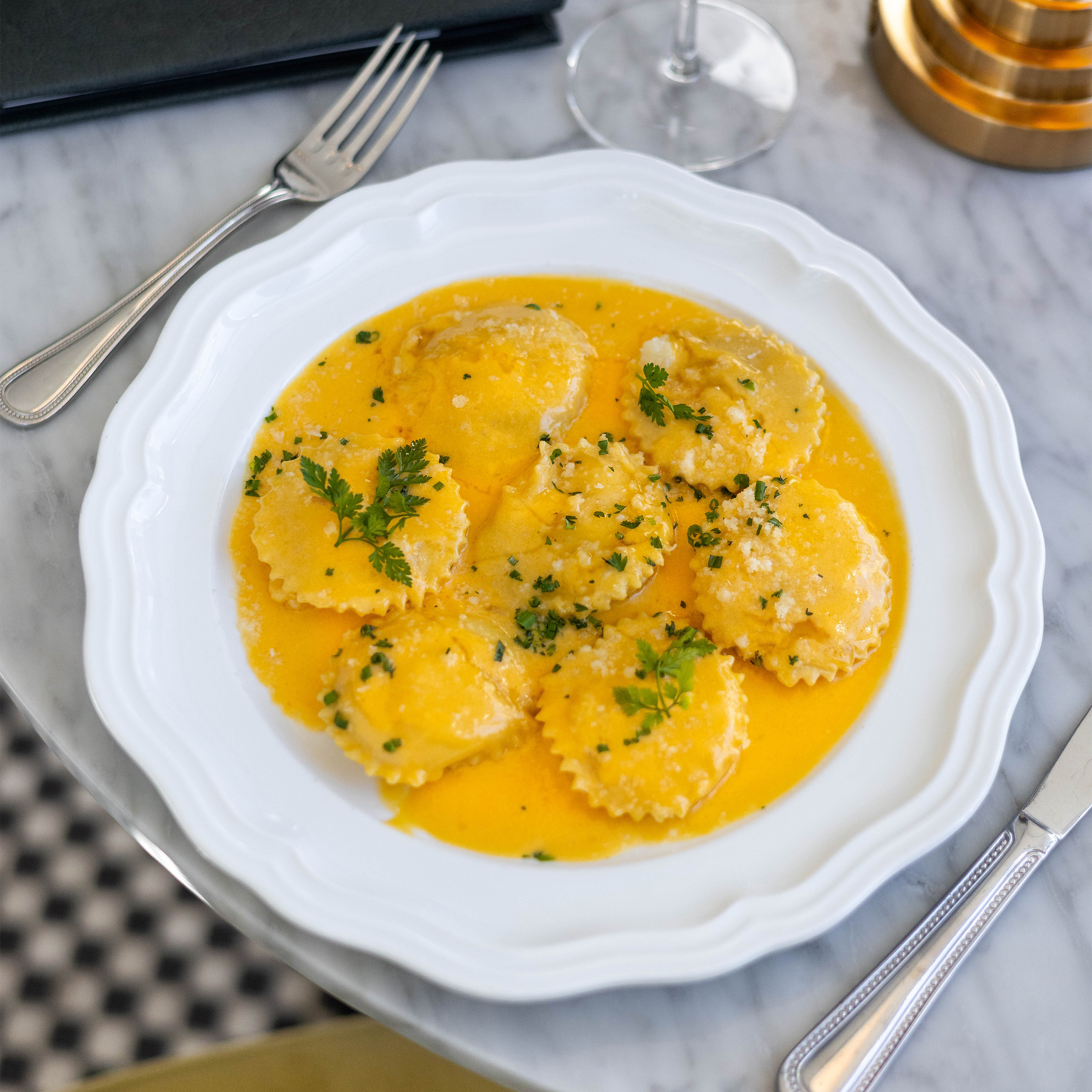Lamb chops at Barbouzard, which brings the south of France to DC. Photograph by Scott Suchman.
Ever since Jackie Kennedy tapped René Verdon to oversee the White House kitchen in 1961, French cuisine has had a grip on DC’s dining culture. These days, largely thanks to the decade-long popularity of Le Diplomate, Washington feels less like a steakhouse town and more like a brasserie town. The two genres, after all, have a lot in common, with approachable food, predictable menus, and lengthy wine lists. If you’re going to open a restaurant, a risk-averse move is to trick out your dining room with red leather banquettes and start slinging smash burgers and onion soup.
How refreshing it is, then, to walk into Barbouzard, the sprawling and swank new dining room that serves dinner till midnight (1 am on weekends, which is perhaps wishful thinking given its location in a K Street office building). It is of a different class entirely, with buttery lighting, flourishing palm trees, and nary a faux-smoke-stained ceiling in sight. Even more exciting, the place marks the return of Cedric Maupillier, who closed his beloved Shaw restaurant, Convivial, at the end of last year.
At that place, Maupillier leaned into homey bistro basics such as roast chicken with tarragon cream sauce and frisée-and-lardon salad. It was easy to forget that he’s a native of Toulon, on France’s Mediterranean coast. Here, though, the Riviera’s influence is strong.
Take the bread service, a gratis tray bearing slices of beautifully crafted baguette. You can choose to slather it the French way, in butter sprinkled with flaky salt, or channel the Med with a dish of olive oil and balsamic. It’s a generous way to start, but don’t skip the snacks, including tiny square chickpea pancakes with creamy scallion dip; opulent layered cubes of brioche, foie gras terrine, and port jelly; and gougères (the already cheesy puffs are served with even more cheese—a Comté fondue).
The $28 bite-size Dungeness tartlets topped with watery crab and caviar, though? Just say no. And there’s a bigger flaw: The menu is trying to accomplish too much. Beyond those snacks, there are ten appetizers, plus oysters and seafood plateaux and caviar and crudos. In the last category, go for the daurade tartare with tomato ponzu.
Here’s a crib sheet for the other half of the menu. Pastas, including linguine with clams or poached lobster, tended to be too salty. Of the meatier plates, the lamb chops, grilled and strewn with garlic cloves, were the standout—skip the aggressively smoky duck à l’orange. And seafood is a smart way to go, whether a deconstructed bouillabaisse, a buttery Dover sole punched up with capers and artichoke, or a smaller plate of scallops and corn custard, with a broth redolent of curry and lemongrass.
And as much as I enjoyed the Grand Marnier soufflé and a classic crème brûlée, the more creative desserts—especially a made-for-Instagram tiramisu presented as a tin of caviar—were a weaker finish.

 The dining room at Brasserie Royale. Photograph by Kelsey Shoemaker.
The dining room at Brasserie Royale. Photograph by Kelsey Shoemaker.
In a retail development in Sterling, Brasserie Royale follows the more standard Parisian/American bistro script (smash burger and all). But impressively, the place doesn’t come off as cookie-cutter. The restaurant is the latest from Ally and Michael Stebner, the chef/owners behind the nearby farm-to-table restaurant Local Provisions. And there’s charm from the moment you walk into the snug bar and dining room, with their peppy soundtrack, miniature paintings, and big, sunny windows.
Hat tip to the Stebners for their if-it-ain’t-broke approach to onion soup. They faithfully use Julia Child’s recipe, and it’s terrific—more about the deeply caramelized onions and broth than about gobs of cheese. (If you’re in the mood for that, order the deliciously crispy Brie.) Oeufs mayonnaise—just soft-boiled eggs with freshly whipped, mustard-laced mayo—isn’t the prettiest plate, but the flavor makes up for it. Tuna tartare is another winner, done up with mustard and capers as if it were beef. That said, I wish the housemade baguette had been better, and that it didn’t cost $6 extra. And you might laugh when you pay $2 more for garlic-and-herb-topped fries—which gets you a single clove of garlic and a few needles of rosemary.
The kitchen plays it straight when it needs to: The lovely trout amandine is as textbook as it gets. But it also lends subtle tweaks to dishes like goat-cheese ravioli with tomato butter—an improbable dash of lavender honey makes it even tastier. And halibut is turned into a strapping plate with mashed potatoes; caramelized mushrooms and leeks; and mustard jus. I can’t think of anything better—or, in the Virginia burbs, a better place to be—on a cold night.
Barbouzard
location_on1700 K St., NW

 Bouillabaisse with four types of fish at Barbouzard. Photograph by Scott Suchman.
Bouillabaisse with four types of fish at Barbouzard. Photograph by Scott Suchman.
Open Tuesday through Friday for lunch and dinner, Saturday for dinner, Sunday for brunch.
Neighborhood: Lobbyist Row–a.k.a. K Street in downtown DC.
Dress: There’s a dress code (no shorts, athletic wear, or anything “too revealing”), but jeans are absolutely fine.
Best dishes: Gougères; panisse with scallion dip; daurade crudo; scallops with corn custard; lamb chops; Dover sole; bouillabaisse; Grand Marnier soufflé.
Price range: Starters and snacks $16 to $28, entrées $26 to $84.
Bottom line: A study in contrasts–Riviera vibes, an office-building setting, and a luxe, but up-and-down, menu from esteemed French chef Cedric Maupillier.
Brasserie Royale
location_on46290 Cranston St., Sterling

 Brasserie Royale’s goat-cheese ravioli. Photograph by Kelsey Shoemaker.
Brasserie Royale’s goat-cheese ravioli. Photograph by Kelsey Shoemaker.
Open Monday through Friday for lunch and dinner, Saturday and Sunday for brunch and dinner.
Neighborhood: Sterling’s Cascades Marketplace.
Dress: Casual–this is a place you could pop into during a day of errands.
Best dishes: Tuna tartare; oeufs mayonnaise; crispy Brie; onion soup; goat-cheese ravioli; trout amandine; halibut with mashed potatoes.
Price range: Starters $8 to $24, entrées $19 to $38.
Bottom line: A true neighborhood spot–cozy and kid-friendly–with familiar but destination-worthy bistro cooking.
This article appears in the November 2025 issue of Washingtonian.
Executive Food Editor/Critic
Ann Limpert joined Washingtonian in late 2003. She was previously an editorial assistant at Entertainment Weekly and a cook in New York restaurant kitchens, and she is a graduate of the Institute of Culinary Education. She lives in Petworth.


Dining and Cooking